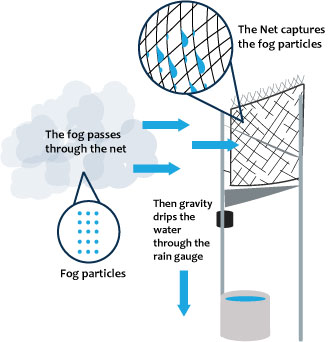What is a standard fog collector?
It is a piece of research instrumentation made to certain standards to
provide a consistent measurement of the fog water collected anywhere fog exists.
We provide support for people who want to build and deploy fog collectors.
It is a piece of research instrumentation made to certain standards to
provide a consistent measurement of the fog water collected anywhere fog exists.

We encourage you to build your own standard fog collectors and we provide instructions for you to do so, free of charge. The standard fog collector (also called an SFC) has a fog-collecting area of 1.00 square meters and is set up such that its base is 2 meters above the ground and its top is 3 meters above the ground. The mesh support itself is made from half-inch copper pipe, as are the spacers. The support legs are made out of 1-inch galvanized pipe. A trough, which is 15 cm wide and whose bottom slants downward across the base of the mesh, routes any water collected to one side of the collector for storage or measurement. We can sell you the international standard raschel mesh, which is used throughout the world, and allows any data that you collect to be fairly compared to data collected by other researchers using this same mesh. Here are directions for assembly of the poles, the spacers, the trough and the square mesh. You can also purchase directions on how to fabricate them.
The SFC was described in a 1994 paper by Schemenauer and Cereceda and there are numerous publications that document its use. It is designed for helping you to determine if a large fog collector (LFC) is warranted for the collection of significant amounts of water. Note that the larger the area of the fog collector, the more water it is capable of harvesting during a fog event. Large fog collectors of 48 square meters have been deployed in numerous locations around the world, including in Chile, Guatemala, Peru, Eritrea, and other countries. They require significant structural integrity to deploy. Medium fog collectors (MFC's) can also be deployed that are somewhere between the size of a standard fog collector and a large fog collector. MFC's may be more manageable to deploy and maintain than LFC's and still provide reasonable amounts of water.
Dan Fernandez has been a professor at California State University, Monterey Bay since 1996. He teaches classes in physics, systems thinking, infrastructure, sustainability, and capstone for Environmental Studies students. His research in the collection of water from fog began in 2005 and he has a 2011 TEDx talk that describes some of his early work. He currently has several dozen SFC's deployed throughout the state that he is using for research purposes related to the effectiveness of different mesh types, the spatial and temporal variability of fog, and the effects of fog water on various ecosystems.
As a result of numerous queries and significant interest that he receives on a regular basis about how to build and deploy fog collectors, he created Bayside Fog Collectors to provide information to those who are interested in working with this fascinating phenomenon.